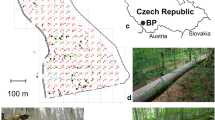Abstract
Most of the investigated fir stumps (79%), aged 2–4 years after tree cutting, were occupied by cambio-and xylophagous insects (on average 32 individuals per 1 stump). There were identified 2 cambiophages, 1 cambio-xylophagous species and 5 xylophages.
Colonization density of these insects in fir stumps was influenced by microhabitat and trophic conditions. The highest density was found in fir stumps without mosses and lichens cover, moderately decomposed and wet, situated in partly insolated places.
Fir stumps are a good base for reproduction and development of secondary and technical invaders of wood, which is important for forest management. Of particular significance isPissodes piceae that apart from stumps invades also weakened and withering fir trees, causing their death.
Similar content being viewed by others
References
Brauns A., 1970: Taschenbuch der Waldinsekten, Stuttgart, Gustaf Fischer Verlag.
Capecki, Z., 1982: Untersuchungen über Tannen-Sekundärschädlinge und deren Bekämpfung. (In Polish with German summary.) Pr. IBL. 593, 1–94.
Dominik, J.;Starzyk, J. R., 1989: Wood Protection. Wood damaging insects. (In Polish.) Warszawa PWRiL.
Fisz, M., 1980: Wahrscheinlichkeitsrechnung und mathematische Statistik, Berlin, VEB Deutscher Verlag der Wissenschaften
Franch, J., 1986: Evolución físico-Quimica de la albura de tocones dePinus silvestris durante su proceso de descompocitión. Pirineos127, 119–152.
Franch, J., 1989: Some regularities in invertebrate succesion in different microhabitats on pine stumps. Orsis4, 69–79.
Franch, J.;Espadaler, X., 1988: Ants as colonizing agents for pine stumps in San Juan de la Peña (Huesca, Spain), Vie Milieu38, 149–154.
Hayes, A. J.;Tickell, R. F., 1984: Colonisation of coniferous stumps by cermbycid beetles (Coleoptera: Cerambycidae). Scot. for.38, 17–32.
Kailidis, D. S., Georgevits, R. P. 1972: Forstinsekten Griechenlands. Tanneninsekten. Anz. Schädlk.54, 25–28.
Starzyk, J. R., Fizia, E., 1984: Entomofauna of fir stumps in the Forest Experimental Station in Krynica (Beskid Sądecki Mts). (In Polish with English summary.) Acta Agr. Silv., Ser Silv.23, 89–103.
Starzyk, J. R., Sęk, A., 1983: Communities and associations of insects in Norway spruce stumps on the selected areas of the Forest Experimental Station in Krynica (Beskid Sądecki Mts). (In Polish with English summary.) Acta Agr. Silv.,Ser silv.22, 71–86.
Wląckowski, S. K., 1958: The entomofauna of pine stumps in relation to the age and size of stump. (In Polish with English summary.) Ekol. Pol.5, 13–140.
Author information
Authors and Affiliations
Additional information
With 1 figure and 3 tables
This research was supported by Grant nr 6 6326 91 02 from the Komitet Badań Naukowych.
Rights and permissions
About this article
Cite this article
Podlaski, R. The effect of microhabitat and trophic conditions on the colonization density of cambio-and xylophagous insects in fir stumps (Abies alba Mill.) in selected stands of the świętokrzyskie mountains (Poland). Anz. Schadlingskde., Pflanzenschutz, Umweltschutz 69, 186–189 (1996). https://doi.org/10.1007/BF01908443
Issue Date:
DOI: https://doi.org/10.1007/BF01908443




